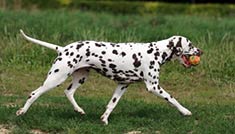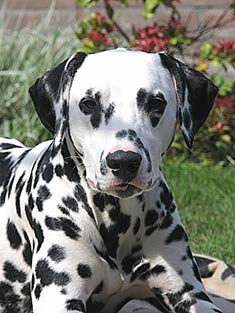Dog Breed:
Dalmatian

Description:
Popular beyond what you would otherwise expect (because of the Disney movies), the Dalmatian is a strong and muscular, athletic dog breed with a great deal of energy. It is especially suited as a jogging companion due to its need for exercise.

Country of Origin:
The Dalmatian originated in Dalmatia, a region in Croatia.
Height:
Male Dalmatians range from 22 inches to 24 inches. Female Dalmatians range from 20 inches to 22 inches.f
Weight:
Dalmatians range from 40 to 60 pounds.
Colors:
Dalmatians have white coats with either black or liver spots.
Coat:
Dalmatians have a short, smooth and shedding coat that requires brushing once a week.
Temperament:
The Dalmatian is a sensitive and loyal dog breed who bonds very closely with its owner. Friendly and playful, it can also be prone to behavior problems. They are easily excitable.
Health Concerns:
The Dalmatian is susceptible to inheriting deafness, urinary stones and skin allergies.
Life Expectancy:
The expected life span of the Dalmatian is 12-14 years.
Living Environment:
Dalmatians will do best in a house with a fenced yard. Dalmatians require active owners because this dog breed has a lot of energy to burn.
AKC Group:
The Dalmatian is in the Non-Sporting group.
If you only think of the Dalmatian as the dog sitting atop the fire truck, you’ve got another think coming. These active, loyal dogs are great companion animals, even if you don’t live in a firehouse.
Where did the Dalmatian come from?
While some dog breeds can trace their history back to a specific country of origin, the Dalmatian’s origins are something of a mystery. The breed was first shown in England in 1862, but there is a region of Croatia named Dalmatia, which may be where the breed was originally developed as a guard dog.
What are Dalmatians used for?
Because of the Dalmatian’s natural love of other animals including horses, the breed was used historically as a carriage dog, running alongside coaches to keep people and small animals from bothering the horses. This is likely the reason they have been so strongly associated with the fire service, as they assisted early horse-drawn fire engines in getting through crowded streets to a fire. When fire engines became motorized, the Dalmatian retained its status as the firehouse mascot, and may have been used as a guard dog to protect the firehouse, its occupants and equipment.
Similarly, Dalmatians were used to guard horse-drawn beer wagons on their delivery rounds. Even today, the Anheuser-Busch company shows its Clydesdale-driven Budweiser beer wagon with a Dalmatian keeping the driver company. If you look closely at the commercials featuring the Clydesdales, you will nearly always see a Dalmatian somewhere nearby.
Dalmatians have been used as exterminators to keep homes free of rats and other vermin. Drawing on this strong hunting instinct, they have been used in a variety of sporting capacities including retrieving downed birds and pointing the way to hidden game. Because the breed is so distinctive in its markings and is so smart, they have been popular circus dogs throughout the years.
What should a Dalmatian look like?
If you look at a very young Dalmatian puppy, you may be surprised to find he or she is totally white! Not to worry, spots will develop within the first few weeks of life. The most common coloring includes either brown or black spots on a mostly white dog. Liver coloring is recessive, meaning that if you breed two liver-spotted dogs, you will get only liver-spotted puppies, but if you breed two black spotted dogs who carry the recessive gene, you will likely get some black-spotted and some liver-spotted puppies.
There are some less common colors, but they are not allowable in the show ring. These less common spot colors include blue, orange, brindle, mosaic, and tri-color.
A patch of color, most common on the head and ears, is a disqualification for the show ring. Any spot larger than the size of a half-dollar would be considered a patch.
Dalmatians may have brown, amber, or blue eyes, and sometimes have one blue and one brown. Depending on which kennel club is sanctioning a particular show, eye color may or may not be a disqualifying factor. The American Kennel Club accepts blue eyes, while the Canadian Kennel Club does not. In the United Kingdom, black-spotted dogs must have dark eyes, and liver-spotted dogs must have amber eyes to qualify for the show ring.
The fully grown Dalmatian should weigh between 35 and 65 pounds, and stand 19 – 25 inches high at the withers. The body should be approximately square when viewed from the side. The pendulous ears are set fairly high on the head and tapered toward the tip. Toenails should be white or the same color as the spots.
The short, fine fur sheds a lot, all year round. While frequent grooming may cut down on the amount of shedding, nothing eliminates it entirely.
Is it hard to train a Dalmatian?
Dalmatians are very smart dogs and have great memories, making them a delight to train. However, they do have a stubborn streak and do not respond well to harsh training methods such as pinch collars. Training should include lots of praise and attention. Positive training may take a little longer, but produces much better results than punitive training methods.
How does the Dalmatian do in families?
The Dalmatian is a very social dog and will enjoy being part of a family, as long as he is not left alone for long periods of time. They do well with other animals in the home, but should be closely supervised around young or rowdy children.
This breed is very active and has a high exercise need. Those with more sedentary lifestyles should probably consider a different breed. The Dalmatian needs daily exercise, brisk walking at a minimum.
Is the Dalmatian a healthy breed?
Properly and carefully bred, the Dalmatian can be as healthy as any other breed. The average life span is 11 to 13 years, but they can live as long as 17 to 18 years. Most health problems, such as arthritis, result from advancing age.
Male Dalmatians over the age of ten are prone to bladder stones, a very painful condition caused by a problem in the liver. For this reason, parents should limit the amount of calcium and purine fed to the dog. Purine is found in organ meats like liver, and in animal by-products.
The major genetic problem common to Dalmatians is deafness, with about 30% of dogs suffering hearing impairment. It appears that deafness is associated with the light coloration of the coat. Dogs who have patches of color, a show ring disqualification, tend to have a lower rate of deafness. Blue-eyed Dalmatians have a higher incidence of hearing impairment than dogs with brown eyes, which is why some kennel clubs disqualify blue-eyed Dalmatians.
As young as five weeks of age, puppies can and should be tested for deafness using a Brainstem Auditory Evoked Response (BAER) test. Typically, puppies who test as totally deaf are usually euthanized, although there is disagreement as to what to do with puppies who are deaf in only one ear. Before you feel sorry for the euthanized dogs, consider their quality of life. According to the Dalmatian Club of America, adopting a deaf Dalmatian means
you will be letting yourself in for a lot of work and probable heartbreak: work, because the dog cannot hear you, and for all but the most experienced handlers is rendered untrainable; probable heartbreak, because if the dog ever escapes from you, he cannot hear traffic. You can conclude the ending. The deaf dog leads a sadly neurotic life, as every hand on his fur or step on the floor startles him because he cannot hear. Most deaf dogs become so fearful and timid that they must be put to sleep anyway; it is better to do so right after the BAER test proves the dog deaf, before a family is attached to the dog.
Dogs with any hearing impairment should not be bred. If you are seeking a Dalmatian puppy, ask the breeder to show you the results of any BAER testing that has been done on the puppies before you take one home.
101 Dalmatians
The book by Dodie Smith and the two Disney movies based on it resulted in a massive increase in the popularity of the Dalmatian. Unfortunately, many irresponsible people who wanted to make a quick buck began breeding Dalmatians without any thought of genetic planning. Genetic defects were common, and prospective families were not screened to see if they could handle such a high-energy, shedding dog.
After the 1996 re-make of 101 Dalmatians, ownership of Dalmatians surged, but people soon found out that this breed is not the easiest one to have in your home. They shed, and they require daily vigorous exercise. Many dogs ended up in shelters and rescues when families found they simply didn’t want to do this much work for a dog. From 2000 – 2010, there was a 90% decrease in the number of Dalmatians registered with the AKC.
This breed definitely requires that prospective puppy buyers pay attention to breeding. Improperly bred dogs have a high incidence of deafness and other genetic problems. They are also likely to be very hyperactive. Make sure you see the parents before you take the puppy, and ask the breeder lots of questions to ascertain whether or not care was taken to genetically strengthen the breed by selectively mating only certain dogs.
Is the Dalmatian the right breed for me?
If you are looking for a great family companion who is highly intelligent and loyal, the Dalmatian may be just right. However, if you cannot provide adequate exercise opportunities and if shedding bothers you, it might be better to look elsewhere.
One great resource is this list of 101 things to think about before breeding (or buying) a Dalmation from the Dalmation Information Station.